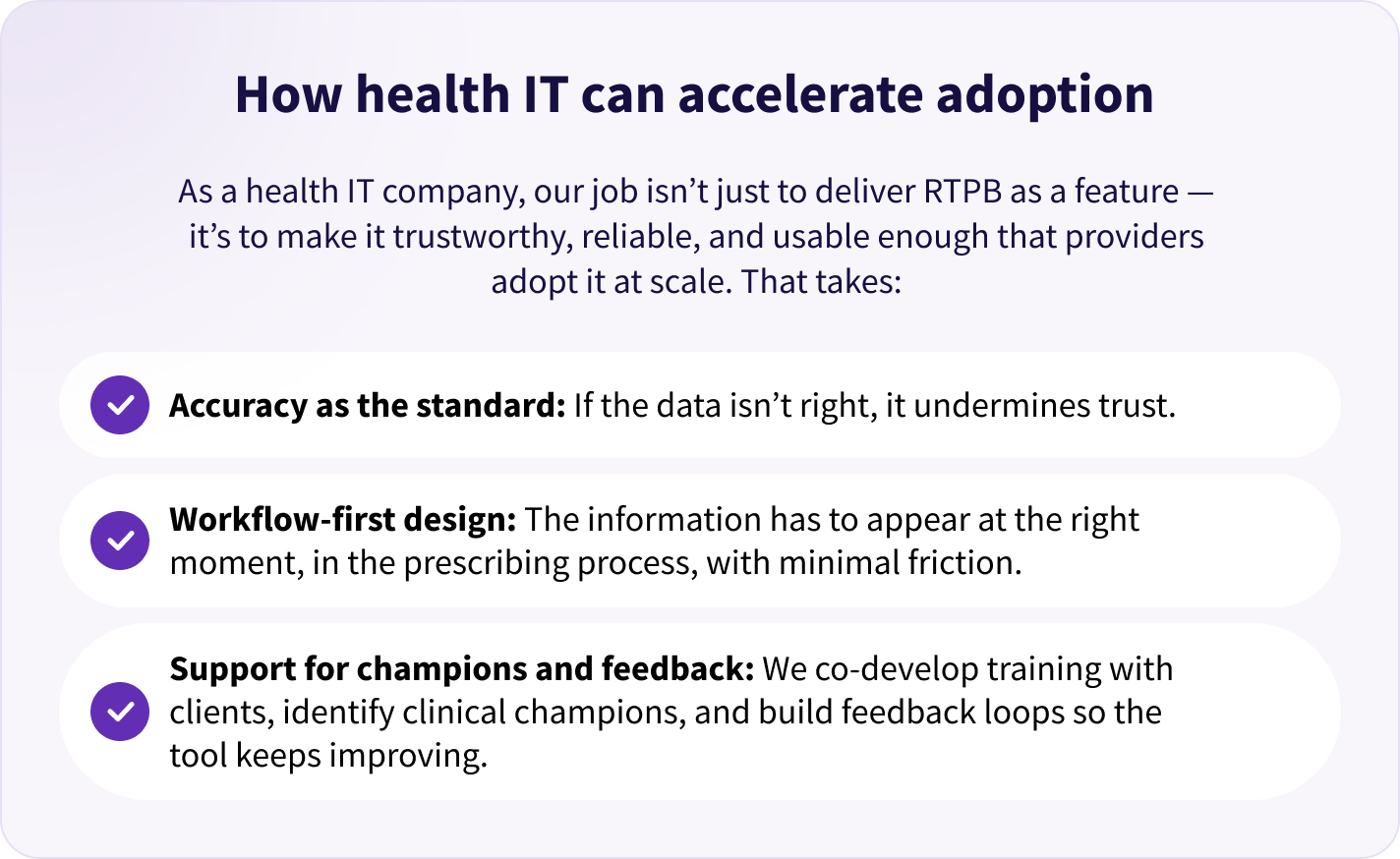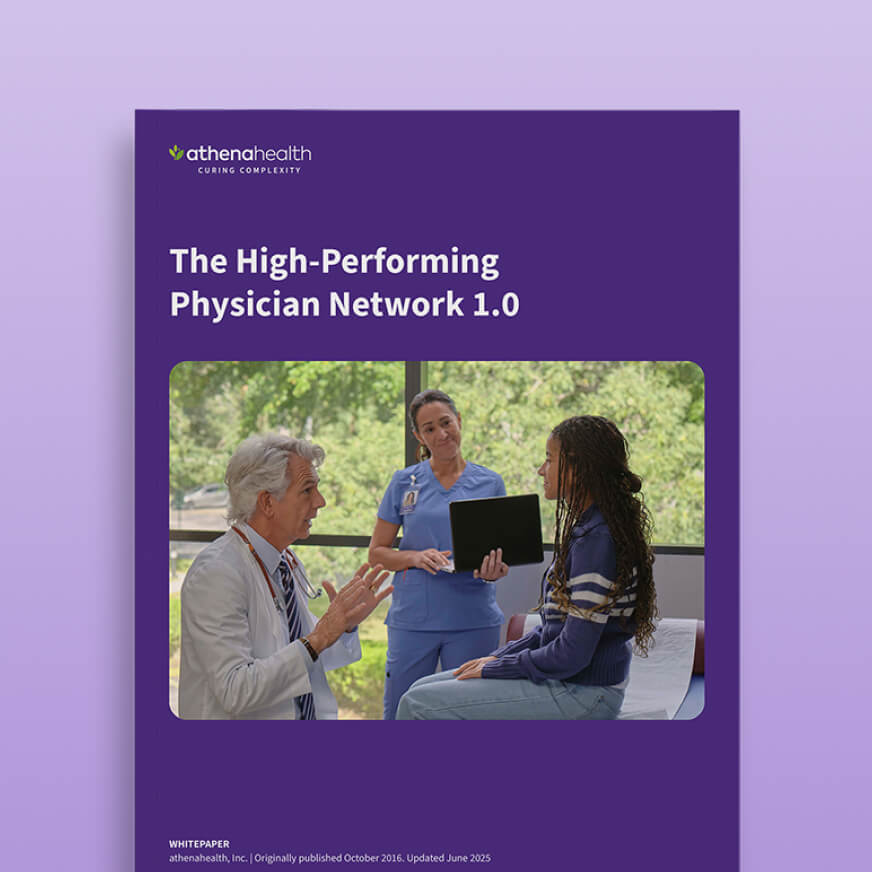Cost is a vital sign for providers, payers, and patients when deciding what Rx to prescribe
A few weeks ago, I joined a Becker’s Healthcare and Arrive Health webinar alongside leaders from OptumRx, Arrive Health, and MultiCare Health System. The discussion centered on real-time prescription benefit (RTPB) — what it delivers today, where it still falls short, and how it can reshape prescribing decisions and conversations.
The theme that came through is one I’ve seen throughout my career in health IT: clinicians have always prescribed with the best intent, but rarely with visibility into the cost of what they are ordering. My father practiced medicine in an era when cost was invisible at the point of prescribing — for too many clinicians today, that’s still the case.
I often explain the problem with a simple analogy: imagine if your job is to design a car and you can source any kind of parts you want, but no one will tell you how much the parts cost. You’d build a really expensive car. It might be a really fun car, but it would likely be a really expensive one. That’s essentially what prescribing is like without RTPB — done with good intent, but without consideration of financial impact.
As I said during the webinar, introducing cost information to providers’ decisions is a unique concept for healthcare. I don’t think it should be, but for most of what providers order, they order blind to cost. Doctors know the efficacy, side effects, and risks of a medication. What they don’t know is how much it is going to cost the patient standing in front of them. And, if the patient can’t afford the medication, they may go without – often without the provider’s knowledge. RTPB changes that equation by embedding cost and coverage information directly into the prescribing workflow, so both prescriber and patient know in advance how much a medication will cost at the pharmacy.
Trust requires accuracy across the five rights
On the panel, my fellow panelist Dr. Brett Walker, associate chief medical information officer at MultiCare, reminded us that any clinical decision support feature only works when it meets the “five rights”: the right information, to the right person, in the right format, through the right channel, at the right time. If the first right fails — accuracy — the rest collapse.
As a healthcare IT product leader responsible for clinical decision support tools, I agree completely. If something is wrong once out of 50 times, a doctor may say, ‘This is useless. It never works. It's always wrong.’ Either the tool delivers the right data consistently, or clinicians abandon it. It’s not a risk they will take, and you’ll have to work hard to rebuild that trust for every new tool after that. Because physician trust is a precious commodity, at athenahealth, we design RTPB features so that when we can’t be certain the information is reliable, the system stays quiet rather than risking a wrong answer.
Physicians also won’t use a feature — no matter how useful we may think it is — if it’s hard to use and disrupts their workflows. That’s why, at athenahealth, we focus relentlessly on usability. As I often tell my teams, the most important thing you can do is spend time watching people use the software, because the workflows that you think exist are not the real-world workflows. For RTPB, that means surfacing insights during the prescribing workflow and placing them where clinicians are already focused, not burying insights in clicks or after the Rx order is sent. In product design that shifts healthcare toward a more integrated and sustainable future, we have to think about “how” something works as much or even more than “what” a feature does.
Affordability and adherence as outcomes
One of the most powerful data points shared during the webinar came from Lauren Hackenberg, Senior Director of Provider Capabilities at OptumRx. Their internal study determined that the average patient savings when using real-time prescription benefit is $214 each time a patient switches to a lower-cost medication. Beyond cost, their data showed a 5%-6% lift in medication adherence when RTPB is used — meaning more patients followed their provider’s care plan to improve their health.
Those results from OptumRx validate what we see every day. When clinicians can see accurate cost and coverage in real time, they can bring patients into the decision-making process. Instead of prescribing blind and hoping for the best, they can discuss options patients are able to follow. That helps lower out-of-pocket costs and improves adherence, supports quality measures, and strengthens the provider-patient relationship.
Prior authorization relief and operational efficiency
The benefits extend beyond affordability. As OptumRx also highlighted, about a quarter of RTPB-driven switches avoid prior authorization. Each avoided prior auth saves providers 20 to 40 minutes, and — more importantly — prevents treatment delays that often frustrate patients.
I’ve heard countless stories of practices drowning in prior auth tasks. RTPB reduces this burden by steering prescriptions toward covered alternatives in real time. Pharmacies feel the difference too, processing cleaner scripts that save about four minutes per paid claim. What looks like incremental time savings at the transaction level becomes a major operational gain at scale.
Building reliable data pipelines
RTPB depends on data moving cleanly between the EHR, the network, and the pharmacy benefit manager (PBM) like OptumRx. That isn’t always straightforward. For the system to return a result, the prescription must be written in a structured way the PBM can understand, but clinicians don’t always write in structured formats.
At athenahealth, we’re applying AI to bridge that gap. As I explained during the discussion, we're using AI tools today to take unstructured sigs and structure them so that we can provide RTPB information to our providers. On the network side, partners like Arrive Health help translate between what an EHR sends and what PBM claim systems require. The more reliable these data pathways become, the more often clinicians see useful results — and the more likely they are to adopt the tool.
When clinicians can see accurate cost and coverage in real time, they can bring patients into the decision-making process.

When adoption grows, the system as a whole benefits. Patients save money and adhere to their therapies; providers spend less time fighting prior authorizations, and payers see lower costs of care.
Bringing cost into the exam room
For far too long, clinicians have practiced without visibility into affordability and coverage. RTPB brings that missing information into the exam room. By embedding real-time cost and coverage into prescribing workflows, we can align the best clinical decision with what patients can access and afford — making care more sustainable and effective for everyone.
That’s one way technology should serve healthcare — not as another layer of complexity, but as a bridge between clinical judgment and patient reality.












